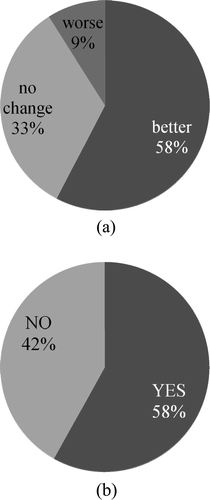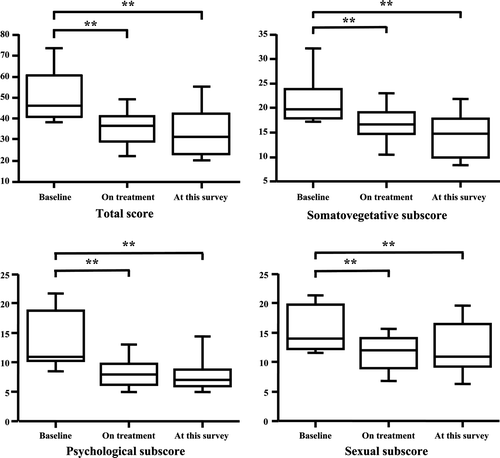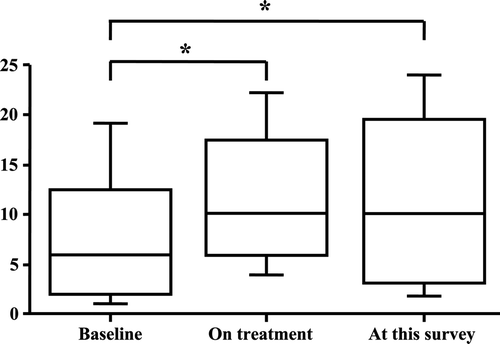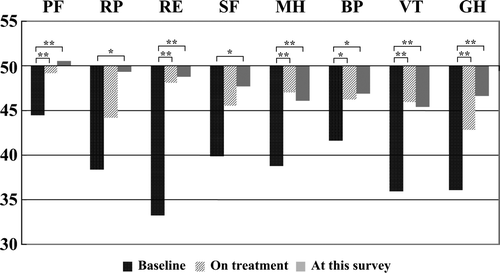Abstract
Objective. There are few reports on the prognosis of patients receiving androgen replacement therapy (ART). In this study, we evaluated the subsequent symptoms of Japanese hypogonadal patients who had received ART, within several years previously by mail-in survey.
Methods. Thirty-three aged men with symptoms of hypogonadism and testosterone deficiency who had received ART for 6 months responded to this survey. The survey consisted of questions associated with present physical and mental status and desire to resume ART. The Aging male’s symptoms (AMS) scale, IIEF-5 and SF-36 were also evaluated at pre-initiation, termination of ART and the time of the survey.
Results. The mean duration from the last treatment was 55 months. Compared with the treatment period, more than half of patients (57.5%) answered that their present condition was better. Scores on the AMS scale, IIEF and SF-36 were all improved significantly in the early stages of treatment and not worsened a long period of time after ART was discontinued.
Conclusions. For symptomatic Japanese hypogonadal patients, subjective effects of treatment were observed during the early treatment period and remained unchanged after discontinuation of ART. A short treatment period may thus be adequate in Japanese hypogonadal patients as regards symptomatic changes.
Introduction
Aging men sometimes present with low levels of serum testosterone and symptoms suggestive of testosterone deficiency such as a decreased sense of well-being, low libido, sexual dysfunction and depression. In Japan, more than 70% of aging men who visited the specialised clinic for hypogonadism complained worthlessness feeling, decline of drive, erectile dysfunction and decline of libido [Citation1]. These symptoms attributable to hypogonadism may result in significant decrease in quality of life [Citation2]. Androgen replacement therapy (ART) is the first-line therapy for hypogonadism. With the aging society, the number of patients treated with ART has also increased in Japan.
For ART, various testosterone medications such as patches, gels and oral drugs can be used in most countries. However, in Japan, only intramuscular injection of testosterone enanthate (TE) can be used for ART. Although it has been reported that ART can improve the symptoms of hypogonadism [Citation3–6], few reports are available on the long-term outcome of ART. In our specialised clinic for hypogonadism in men, we have for various reasons performed ART for a maximum of 6 months. In this study, we investigated long-term subjective outcome in Japanese hypogonadal patients administered TE as ART for 6 months, and attempted to determine the appropriate period of administration of TE for such patients.
Methods
Of patients who visited our specialised clinic at Kansai Medical University Hospital with symptomatic hypogonadism and testosterone deficiency, 82 were sent questionnaires. A total of 33 men (mean age 57.7 years, range 48–72) returning the questionnaires were included in this survey. They had been treated with ART total for 6 months, and ART had been effective for their symptoms. ART consisted of intramuscular injections of 250 mg of TE every 3 weeks. All men enrolled in this study were evaluated with the Aging males’ symptoms (AMS) scale, the International Index of Erectile Function (IIEF) 5 and the Short-Form 36-item (SF-36) before ART and again at 6 months after the administration of ART [Citation7–9].
The patients completed the mailed questionnaires at home and returned them in postage-prepaid envelopes. The questionnaires included our original questionnaire associated with present physical and mental status and desire to resume ART (), AMS scale, IIEF 5 and SF-36. Among the patients who returned their questionnaires, we analysed the results of those who answered their questionnaires completely at pre-initiation, the termination of ART and the time of the survey. Based on this survey, we evaluated the subsequent symptoms and quality of life of Japanese hypogonadal patients who had received ART within several years previously. The survey was approved by the Ethical Committee of the university hospital.
The Wilcoxon t-test was performed on various sets of data, and differences were considered significant when p values were less than 0.05.
Table I. Our original questionnaire.
Results
The patient response rate was 40.2% (33/82). The mean duration from their last injection was 55.0 months (range 16.7–67.8). None had required re-treatment with ART. The mean serum total and free testosterone levels before ART were 2.85 ± 0.67 ng/ml and 6.56 ± 1.7 pg/ml. The numbers of patients analysed for results of our original questionnaires, the AMS scale, IIEF-5, and SF-36 were 33, 11, 33 and 15, respectively.
The mean total AMS scale score before ART was 50.5, and decreased significantly to 35.7 during ART. The mean somatovegetative, psychological and sexual subscores of the AMS scale were also significantly improved with ART (). In our original questionnaires, 19 of 33 patients (57.5%) answered that their present condition was better, while 11 of the 33 (33.3%) patients had noted no change in symptoms. Eighteen of 31 patients (58%) indicated that they wished to be treated with ART again if necessary in the future (a,b). Among patients who did not wish to be treated any more, the most common reason for this was they had no aging male symptoms (). Furthermore, the mean total AMS scale score and somatovegetative, psychological and sexual subscores, which had improved significantly during ART, had not worsened even approximately 5 years after the discontinuation of treatment (). A significant improvement following ART was also observed in IIEF-5 score. The mean IIEF-5 score before treatment was 8.0, and improved significantly to 12.0 with ART and remained at 11.4 after the ART was discontinued (). Changes in the SF-36 scores are shown in . The SF-36 subcategory scores include standard deviations, where 50 representing the age-matched, healthy Japanese baseline. Prior to ART, the subcategory scores on the SF-36 were all lower than those for healthy Japanese men in their 50s. Nevertheless, several scores significantly improved during ART and remained unchanged even a long period of time after discontinuation of ART, especially those for physical functioning, role-emotional, mental health, vitality and general health subscales. No significant differences were noted between during and after ART in any of subcategory scores.
Table II. Results of our original questionnaires.
Figure 1. Results of our original questionnaires. (a) How do you feel your health status is compared with that under treatment? (b) Do you want to be treated with ART if needed in the future?

Figure 2. AMS scores were significantly improved after androgen replacement therapy (ART), and remained unchanged for a long period of time after discontinuation of ART. *p < 0.05; **p < 0.01, Wilcoxon t-test.

Figure 3. IIEF scores also significantly improved with androgen replacement therapy (ART), and remained unchanged for a long period of time after discontinuation of ART. *p < 0.05, Wilcoxon t-test.

Figure 4. Changes in Short-Form 36-item (SF-36) scores. Prior to ART, the subcategory scores were all lower than those in healthy Japanese men. Except for the RP and SF subcategory scores, all scores were significantly improved during ART, and remained unchanged for a long period of time after discontinuation of ART. *p < 0.05; **p < 0.01, Wilcoxon t-test. PF: physical functioning, RP: role-physical, RE: role-emotional, SF: social functioning, MH: mental health, BP: bodily pain, VT: vitality, GH: general health.

Discussion
Findings from the questionnaires indicated that the AMS scale, IIEF-5 and SF-36 improved following ART, and that these improvements remained unchanged for several years after ART had been discontinued. These findings indicate that, as regards improvement in subjective response, the effectiveness of ART persisted for several years after discontinuation of ART in Japanese hypogonadal patients.
Only those patients who clearly benefited from the ART and maintained such benefit might have answered their questionnaires, since the response rate was low, at 40.7%. Nevertheless, there are several possible explanations, based on our original questionnaire, for this continued subjective effectiveness of ART, one of which is that the diagnosis of ‘hypogonadism’ enabled patients to become aware of the reason for their symptoms, and they therefore improved their lifestyle, since the majority of patients answered that they wished to be treated with ART again if necessary in the future. In addition, the normal process of aging in hypogonadal patients may have caused them to become more tolerant of their symptoms. Although the small sample size and use of a mail-in questionnaire may have limited this investigation, our findings do indicate that in Japanese hypogonadal patients who benefited from ART, this treatment improved their symptoms and quality of life from early on, suggesting that long-term treatment is not necessary.
It has been reported that ART can improve hypogonadal patients [Citation3–6], and at present, ART is first-line treatment for symptomatic such patients. However, the parameters of treatment with ART are still controversial. Several societies in Europe and United States, including the International Society for the Study of the Aging Male (ISSAM), recommend assessment of treatment outcomes and that decisions regarding continuation of treatment be based upon determination of whether 3–6 months is adequate for libido and sexual function, muscle function and improvement of body fat. Improvement in bone mineral density requires a longer period of time to be observed, and for this reason failure to benefit clinically within a reasonable period of time should result in discontinuation of treatment [Citation10]. Moreover, Snyder et al. observed decreased fat mass with testosterone patch for 36 months in aged men [Citation11], and Page et al. demonstrated that administration of TE for 36 months improves physical performance and strength in older men with low serum testosterone [Citation12]. These studies indicated that long-term testosterone administration may be desirable for improvement of body composition metabolism. On the other hand, Tsujimura et al. reported that the AMS scale in Japanese hypodonadal patients had improved significantly during ART, and that improvements were maintained for 3 months after discontinuation. In their study, testosterone levels increased significantly during ART, but decreased after treatment was discontinued. However, as noted, AMS scores were maintained. Furthermore, they suggested that it is unclear whether all hypogonadal-related symptoms can be explained by testosterone deficiency [Citation13].
Our study also evaluated the efficacy of ART in improving the subjective symptoms and quality of life of Japanese hypogonadal patients. Efficacy of ART was observed at an early stage, and was unchanged several years after ART had been discontinued. These findings suggest that intramuscular injection of TE for 6 months may be adequate for improvement of subjective symptoms in Japanese hypogonadism patients who benefited from ART. Future studies should include objective factors such as bone density, fracture rate and body composition, and randomised controlled trials are needed to determine the best duration of ART.
Conclusions
ART was effective in Japanese hypogonadal patients, and improved the patients’ symptoms and quality of life. The effect of ART appeared in early stage of the treatment and did not change at several years after the ART was discontinued. To improve subjective symptoms, the ART for 6 months may be adequate for Japanese hypogonadal patients.
Declaration of interest:
The authors report no conflicts of interest. The authors alone are responsible for the content and writing of the paper.
References
- Kawa G, Taniguchi H, Kinoshita H, Matsuda T. Analysis of the statues of patients visiting our specialized clinic for hypogonadal men: 5-year experience. Hinyokika Kiyo 2009;55:87–92.
- Lunenfeld B, Saad F, Hoesl CE. ISA, ISSAM and EAU recommendations for the investigation, treatment and monitoring of late-onset hypogonadism in males: scientific background and rationale. Aging Male 2005;8:59–74. Review
- Bassil N, Alkaade S, Morley JE. The benefits and risks of testosterone replacement therapy: a review. Ther Clin Risk Manag 2009;5:427–448.
- Morley JE, Perry HM III. Androgen treatment of male hypogonadism in older males. J Steroid Biochem Mol Biol 2003;85:367–373.
- Calof OM, Singh AB, Lee ML, Kenny AM, Urban RJ, Tenover JL, Bhasin S. Adverse events associated with testosterone replacement in middle-aged and older men: a meta-analysis of randomized, placebo-controlled trials. J Gerontol A Biol Sci Med Sci. 2005;60:1451–1457.
- Tenover JS. Effect of testosterone supplementation in the aging male. J Clin Endocrinol Metab 1992;75:1092–1098.
- Heinemann LA, Saad F, Zimmermann T, Novak A, Myon E, Badia X, Potthoff P, T’Sjoen G, Pöllänen P, Goncharow NP, et al. The Aging Males’ Symptoms (AMS) scale: update and compilation of international versions. Health Qual Life Outcome 2003;1:15.
- Rosen RC, Cappelleri JC, Smith MD, Lipsky J, Peña BM. Development and evaluation of an abridged, 5-item version of the International Index of Erectile Function (IIEF-5) as a diagnostic tool for erectile dysfunction. Int J Impot Res 1999;11:319–326.
- Fukuhara S, Bito S, Green J, Hsiao A, Kurokawa K. Translation, adaptation, and validation of the SF-36 Health Survey for use in Japan. J Clin Epidemiol 1998;51:1037–1044.
- Wang C, Nieschlag E, Swerdloff R, Behre HM, Hellstrom WJ, Gooren LJ, Kaufman JM, Legros J-J, Lunenfeld B, Morales A, et al. ISM, ISSAM, EAU, EAA and ASA recommendations: investigation, treatment and monitoring of late-onset hypogonadism in males Aging Male 2009;12:5–12.
- Snyder PJ, Peachey H, Hannoush P, Berlin JA, Loh L, Lenrow DA, Holmes JH, Dlewati A, Santanna J, Rosen CJ, et al. Effect of testosterone treatment on body composition and muscle strength in men over 65 years of age. J Clin Endocrinol Metab 1999;84:2647–2653.
- Page ST, Amory JK, Bowman FD, Anawalt BD, Matsumoto AM, Bremner WJ, Tenover JL. Exogenous testosterone (T) alone or with finasteride increases physical performance, grip strength, and lean body mass in older men with low serum T. J Clin Endocrinol Metab 2005;90:1502–1510.
- Tsujimura A, Takada S, Matsuoka Y, Hirai T, Takao T, Miyagawa Y, Nonomura N, Okuyama A. Is discontinuation of hormone replacement therapy possible for patients with late-onset hypogonadism? Int J Urol 2008;15:625–629.